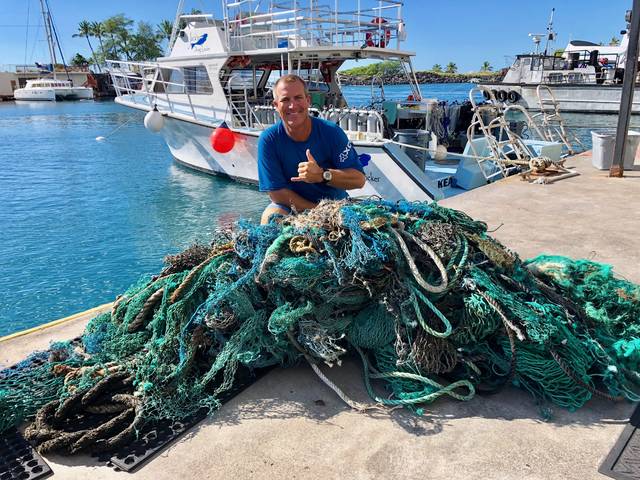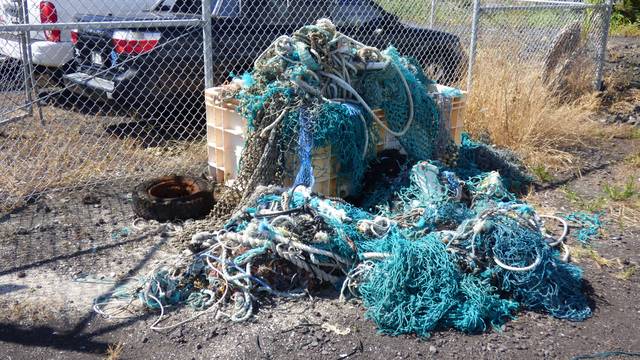Rising tide of trash? Nets, plastics litter West Hawaii waters, shoreline

Capt. Jeremy Bricco, of Jack’s Diving Locker, poses with a haul of nets recently. (Courtesy photo/Jeff Fear)

Trash retrieved from the ocean sits piled up at Honokohau Harbor this week. (Max Dible / West Hawaii Today)
KAILUA-KONA — The ocean is full of fish. And garbage.
KAILUA-KONA — The ocean is full of fish. And garbage.
Neither is a new phenomenon, and it isn’t exactly news that the waters off West Hawaii haven’t been exempt from dangerous pollutants. However, state officials, boat captains and residents in the area have all noticed an apparent uptick in marine debris in recent weeks — namely derelict fishing and cargo nets, plastics and even construction materials.
Capt. Jeff Fear, a long-time commercial fisherman, said plastics and other trash are more or less constant 20-40 miles offshore. Where he’s noticed the increase in debris is at 1,000 fathoms, where nets are the primary problem, and what he referred to as the Ono Lane, located roughly 40-50 fathoms out from the shoreline.
“There’s been a lot of stuff in there the last couple weeks,” Fear said. “You name it, it’s there.”
Carried by the currents, the problematic presence of excess debris both in the water and on the shoreline has plagued Hawaii Island’s entire leeward coast.
Lynda Bertelmann got a group together Tuesday to clear fishing nets, PVC pipe and wooden planks full of nails off the Ala Kahakai Trail that runs the coastline between the Westin Hapuna Beach Resort and the Mauna Kea Beach Hotel.
She said friends of hers living in Kawaihae have seen debris washing up in the bays at Honokoa and Kailapa.
Megan Lamson, fish and habitat monitoring technician with the state Department of Land and Natural Resource’s Division of Aquatic Resources (DAR), said nets have left tangled messes at Pololu and Puako, adding one is currently littering Makalawena Beach.
Capt. Jeremy Bricco, employed by Jack’s Diving Locker, fished a net out of the waters off Kohanaiki Saturday as his boat was departing for the night’s manta ray tour. He estimated the net weighed between 200-250 pounds and said it took three people to pull it aboard.
“For some reason, I don’t know what’s happened, but the last two or three weeks we’ve had a lot of this stuff coming by,” Bricco added.
Lamson, also the Hawaii Island program director for the Hawaii Wildlife Fund, said an apparent increase in marine debris stretches back considerably further that — but added the keyword is “apparent.”
“Anecdotally, yes, the large, derelict fishing net bundles are seemingly on the rise,” she said. “There has been kind of an uptick actually since 2017. But scientifically, I would be uncomfortable saying it’s statistically significant. However, there are fishermen coming into the DAR office, saying, ‘I’ve never seen so much.’”
While nets, lines, plastic and other trash are piling up in the Pacific at an alarming rate, Lamson explained that in the Hawaiian Islands, such debris tends to accumulate on northeastern shores. On Hawaii Island, accumulation is more common along the southeast coast, starting at South Point and stretching several miles northeast.
The prevalence of ocean pollution makes it more or less a certainty that every part of every island will be impacted by marine debris to one degree or another. But Lamson said identifying specific culprits can be as murky as navigating the water they pollute.
“We kind of learned that blaming any one country or any one industry is really ineffective,” she explained. “We all have to recognize the problem and work toward the solution together.”
Lamson added, though, that the Hawaii Wildlife Fund, along with volunteers, has removed more than half a million pounds of marine debris in the last 15 years. By weight, more than 51 percent was comprised of net and line bundles, which are most frequently used for the purposes of fishing and transporting cargo.
Some of the net/line waste may have been intentionally discarded, though Lamson believes most finds itself adrift accidentally.
DAR installed net bin receptacles outside its Kona and Hilo offices in February of 2017 and March of 2018, respectively. Since that time, Lamson said the division has removed around 4,650 pounds of derelict net and line bundles in seven truckloads. The Kona office produced two truckloads in 2017 and already four this year, with a fifth about ready to ship out.
Mark Manuel, Pacific Islands Marine Debris regional coordinator with the National Oceanic and Atmospheric Administration (NOAA), spoke to whether the state should expect even more debris to pile up.
“There is currently no indication that the amount of marine debris in our ocean is decreasing,” said Manuel, naming plastics as the most common type. “Additionally, we don’t have a significant amount of marine debris data (or even a good baseline) in Hawaii to determine whether or not to be expecting more.”
As to the source of the netting strewn about the West Hawaii coastline, as well as all the other islands, Manuel said it’s not originating with Hawaii commercial fishermen, which are part of the long-line industry.
“These nets washing up are mostly from the trawl or purse seine fisheries that occur throughout the Pacific,” said Manuel, adding the sources are both international and domestic.
Ocean current patterns may also play a role in why West Hawaii has apparently been the landing spot for more debris in recent weeks, but Lamson said those patterns can be dynamic and are thus difficult to determine. Several small, local eddies complicate matters further.
As both the source of the pollution and the factors pulling it with a possibly greater frequency into West Hawaii waters remain at least partially obscured, the best solution is to get involved with clean-up efforts.
The Hawaii Wildlife Fund conducts several annually to help combat some of the obvious adverse effects — entangled marine life, inadvertent plastic ingestion, the smothering of coral reefs and the potential import of invasive species.
Fear is also a prominent member of Big Island Wave Riders Against Drugs, which conducts beach clean-ups. As a fisherman, he holds Scoop It events, in which he solicits other boat captains to help clean local waters for the collective good.
“A lot of us guys work at night, so you can’t see (the debris),” Fear said. “One of these times, somebody is going to hit something, and they’re going to sink, and somebody is going to get hurt.”



Is it possible that the recent train of hurricanes may have stirred up the Great Pacific Garbage Patch and/or directed some of that towards us?
It is more than possible, it is a highly likely contributing factor and representative of a much larger global pollution problem.
I think most is just laziness: Too much trouble to retrieve their lines and replacement gear is a tax write off.
Most of 3rd world Asia and Africa use the ocean or rivers that lead to as their personal garbage disposal system. I’ve seen it in person and one would not believe it without seeing it. Until that is fixed (unlikely) nothing really can be done about this issue.
amazing….the trash on the land and in the sea…….sad
Local boaters leave a bit of debris out there as well. Last time I was out at FAD VV, got in close to take a pic of a red footed booby on top. Noticed a large snarl of lines hanging off the buoy in the water. Looked like it was from boats that tied up to the bouy and could not get the lines loose so just let them go. Major prop entanglement hazard.
A day use buoy off Kaiwi point had a mooring like drifting around it, Another failure to untie I would guess. All those lines will eventually come loose and be a debris hazard.
I think you are looking out the wrong end of the telescope you could remove all the boats in the ocean and it would make a near zero difference. 90% of plastic polluting our oceans comes from just 10 rivers. Eight of them are in Asia: the Yangtze; Indus; Yellow; Hai He; Ganges; Pearl; Amur; Mekong; and two in Africa the Nile and the Niger.
hopefully, we can get funding soon to go and remove all of this rubbish! we clearly are inheriting this problem, we have been trying to get funding from the manufacturers and countries.
“The prevalence of ocean pollution makes it more or less a certainty that every part of every island will be impacted by marine debris to one degree or another “…
Earlier this year the BBC reported …”Plastic is one of the biggest threats to the future of coral reefs after ocean warming, say scientists”.
More than 11 billion items of plastic were found on a third of coral reefs surveyed in the Asia-Pacific region. This figure is predicted to increase to more than 15 billion by 2025. Plastic pollution raises by 20-fold the risk of disease outbreaks on coral reefs, according to research.
Increases in climate change-fueled hurricane frequency and intensity are also contributing factors in what appears at times to be a sudden upsurge in abandon fishing gear and trash in our local waters and beaches.
In March of this year, a large and coordinated scientific survey involving some 30 vessels and aircraft determine that the island of garbage between the West Coast and Hawai’i was in fact 16 times larger than previously estimated — some of which finds its way to Hawai’i. This same survey found 80,000 tons of plastic, half of which is fishing industry gear. All together, the plastic poses a significant threat to the food chain, according to the international team of scientists conducting the survey.
Plastic pollution is a global problem – and growing – from the Arctic to the Antarctic, and requires our immediate and coordinated attention from individuals and organizations interested in protecting Hawaii’s marine environment, along with coordinated efforts by local, state, and Federal governments.